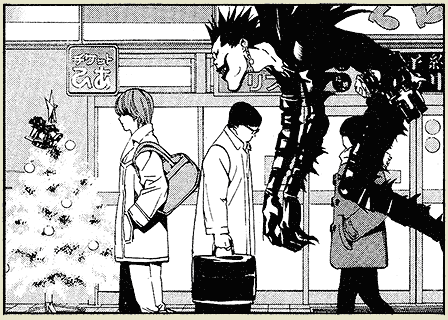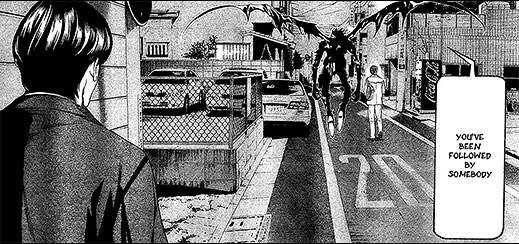Death Note
Created by: Tsugumi Ohba and Takeshi Obata
Published by: PUBLISHER
ISBN: 1421501686 Amazon
Pages: 12 vols



This review was originally published in November 2007.
Over the past three weeks I've been burning through one of the most exciting reads I've come across in a while. Death Note is a seat-edged battle of wits that left me exhausted by the end. Heck, I was exhausted by the halfway mark.
Let me start over. Death Note is a Japanese comic that tells its story over the course of twelve volumes (on display now at your local Borders [note from the future: oops]). If what I'm about to say sounds good but you don't feel like spending the eight dollars per volume, head to your local library — they almost certainly carry the books in the Young Adults section. In any case, it's worth your time. Here's why.

The story begins when Ryuk, a death god (known in the story's mythology as shinigami), drops a death note into the human world in order to alleviate the tides of boredom that oppress his everlasting existence. A death note is a special notebook, a tool possessed by shinigami that allows them to take the lives of humans whose names they write into the notebook. Ryuk's dropped notebook happens to fall into the path of Light Yagami, Japan's top high school student, son of a police chief, and Mary-Sue-style genius.
After a couple tests of the book's authenticity and the boundaries of some of its rules (e.g., one must visualize the face of the person whose name he is writing for that person to die), Light decides that he will forge a new world, a utopia in which all who would take advantage of the weakness of others simply die. Rather quickly, the police around the world begin taking notice of the staggering number of criminals who have suddenly died of heart attacks. Suspecting foul play, they want to find the perpetrator because law-and-order and vigilantism have never been the most lusty of bed-fellows. And it doesn't help that Light has gained a popular following amongst the masses who dub him Kira (which sounds remarkably similar to the Japanese pronunciation of the English word killer). So the authorities enlist the assistance of the world's greatest detective (an anonymous man known only as L) and he quickly narrows the range of suspects dramatically, instigating a pulse-pounding game of cat-and-mouse — L vs. Kira.

As exciting as the first couple volumes were, I had a hard time seeing how the story could sustain itself across twelve volumes. The key to Death Note's happy success is the absence of anything really resembling a status quo. The story and its elements are continually in flux. If things remained simple I could see the book resolving in four or five volumes, but everything is constantly moving, constantly changing. It was a fantastic read.
And smart. The fact that you're reading about these very intelligent characters who think things through to incredible lengths only adds to the excitement. There were moments of revelation and counter-revelation that simply blew my mind. There are moments when you think the jig is up for one or more of the characters and then a flashback will reveal the would-be victim's plan from the start and you get to see tables turn and over turn as these characters fight for their lives. In a way, it's kind of a cheat, withholding essential information from the audience in order to up the tension ante, but the solutions are generally smart enough that most readers probably won't mind being led on in this manner.

As well, the moral question explored by the book's author and artist really goes to lengths to get the reader thinking about Means and Ends — and it's not at all clear who one should root for. It helps that Light, despite having an ego that won't quit, is almost entirely unselfish in his motivation. Death Note is, in its way, a narrative distillation of an ethics bomb, an exploration of right and wrong and whys and wherefores.
In case you didn't get it, I highly recommend this series to just about anyone.
Good Ok Bad features reviews of comics, graphic novels, manga, et cetera using a rare and auspicious three-star rating system. Point systems are notoriously fiddly, so here it's been pared down to three simple possibilities:
3 Stars = Good
2 Stars = Ok
1 Star = Bad
I am Seth T. Hahne and these are my reviews.
Browse Reviews By
Other Features
- Best Books of the Year:
- Top 50 of 2024
- Top 50 of 2023
- Top 100 of 2020-22
- Top 75 of 2019
- Top 50 of 2018
- Top 75 of 2017
- Top 75 of 2016
- Top 75 of 2015
- Top 75 of 2014
- Top 35 of 2013
- Top 25 of 2012
- Top 10 of 2011
- Popular Sections:
- All-Time Top 500
- All the Boardgames I've Played
- All the Anime Series I've Seen
- All the Animated Films I've Seen
- Top 75 by Female Creators
- Kids Recommendations
- What I Read: A Reading Log
- Other Features:
- Bookclub Study Guides









